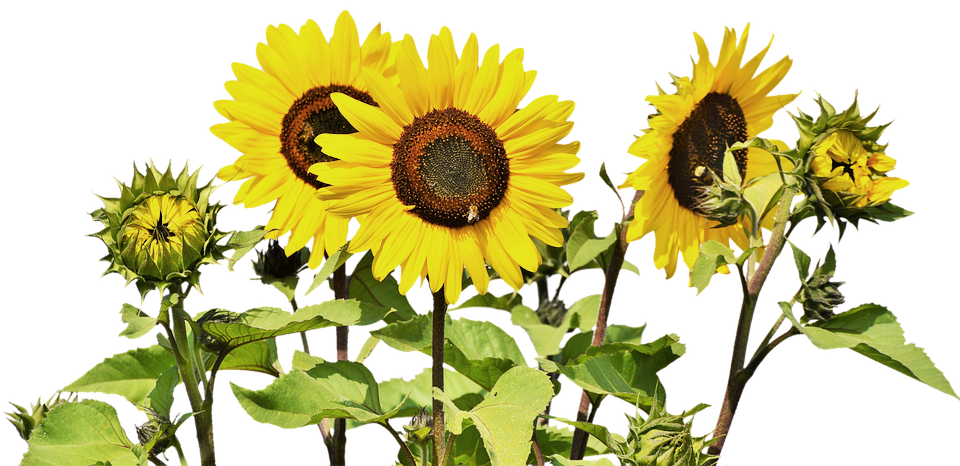
How to Start Composting
By Chris Edmunds
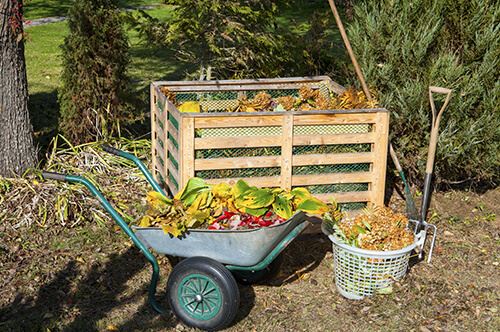
Do you have a composter set up in your garden yet? If not, now is a great time to start. Compost is one of the easiest and most affordable ways to improve your garden, grow healthier plants that produce more fruit, and reduce your waste overall. And composting is not as challenging as you might expect.
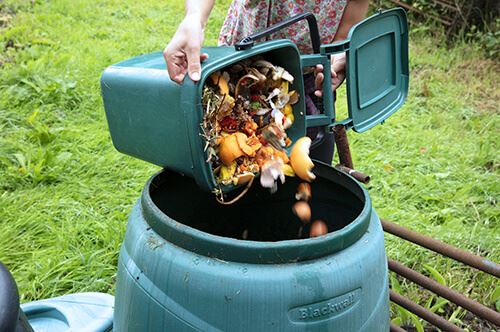 If you have space, you can build your own compost bin out of pallets or a frame with chicken wire. But, if you don't have room for that, or your neighborhood requires closed compost bins, you can buy a contained version quite affordably.
If you have space, you can build your own compost bin out of pallets or a frame with chicken wire. But, if you don't have room for that, or your neighborhood requires closed compost bins, you can buy a contained version quite affordably.
Types of Compost Bins
There are several styles of composting that have proven to work well. Some utilize only worms (known as vermicomposting) and can be used indoors or out. Other methods like layering and simple heaps are meant to compost in place, but take significantly more time. The two most common types of compost bins that are also available to buy are: stationary ones that sit on the ground or elevated ones that can be easily turned with a handle.
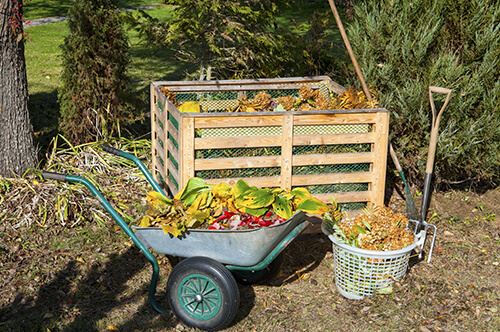 The bonus of an elevated turning compost bin is that it's easy to turn the bin to aerate your compost, which speeds up the breakdown process. The downside to turning bins is that they often hold less volume than stationary bins.
The bonus of an elevated turning compost bin is that it's easy to turn the bin to aerate your compost, which speeds up the breakdown process. The downside to turning bins is that they often hold less volume than stationary bins.
Stationary bins can often hold a lot more compost. Usually, the compost is directly on top of the soil, so earthworms and other bacteria from your soil can easily get in to help the breakdown process. But, it is a lot more challenging to turn and aerate the compost pile in a stationary bin. There are tools available, designed to make the aeration and turning process easier though, and they are a pretty worthwhile investment if you decide to take the stationary route. Turning in a stationary bin is easier with side by side bins so that you can turn the full bin into the empty one, but this does require additional space.
Turning your compost regularly really is the secret to getting that beautiful soil addition as fast as possible.
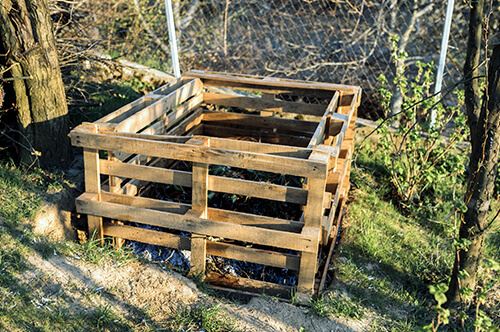 Setting up Your Bin
Setting up Your Bin
Once you have decided on what type of bin is right for you, set it up someplace that's convenient to access from your kitchen but out of the way of bothering neighbors. It's best if it is in a shaded spot, and the area around it is clean and uncrowded to make it less attractive for rodents and pests. It is also important to place it away from shallow rooted trees like maples whose roots may try to grow into your pile.
Start your bin off with a good layer of brown material. A mix of things like dry twigs and leaves, dry grass, wood chips, sawdust, and cardboard, is perfect.
What Can You Compost?
You can compost almost any food prep leftovers from the kitchen, like fruit and veggie peels, the ends of fruits and veggies, cooked fruits and veggies, coffee grounds, shredded black and white newspaper pages, cardboard, paper towels, napkins, etc.
But, you can't compost everything from the kitchen. You should never compost meat, bones, dairy, or fats. These items can attract rodents and other pests. Eggshells are acceptable but should be rinsed and crushed first to break down quickly.
You should never compost items like dog poop bags, or kitty litter, even if they say they're compostable. Things that are marked as compostable on the package are only approved for composting in large scale commercial composting facilities, where they have more control over the temperatures needed to safely compost these types of things. Dog and cat feces can carry pathogens that can make humans really sick, and you can't guarantee your compost will get hot enough to kill those pathogens.
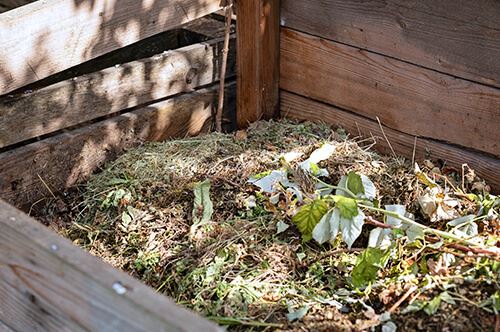 It's a good idea to chop or shred things up into fairly small pieces before putting them in your bin. Small chunks break down a lot faster and are less likely to turn smelly. Take our "Can I Compost This?" quiz to test your knowledge before you start putting things in your bin!
It's a good idea to chop or shred things up into fairly small pieces before putting them in your bin. Small chunks break down a lot faster and are less likely to turn smelly. Take our "Can I Compost This?" quiz to test your knowledge before you start putting things in your bin!
What is Green vs. Brown Matter
Maintaining a good ratio of green and brown matter is important to your compost heap. If you just add all your veggie and fruit scraps to it, but never any dry material like cardboard or dried leaves, you'll end up with a stinky bin full of flies pretty fast.
Your compost needs a balance of green to brown, and the recommended ratio is 4 brown to 1 green. So for every inch of kitchen waste, you'll want to add about 4 inches of brown matter.
Brown matter includes things like cardboard egg cartons, dried grass, twigs and sticks, dead leaves, shredded black and white newspaper, paper towels, napkins, hay or straw, sawdust, dried pine needles, and dried crushed eggshells.
Dead leaves in the fall are one of the best and easiest ways to add brown matter to your compost bin.
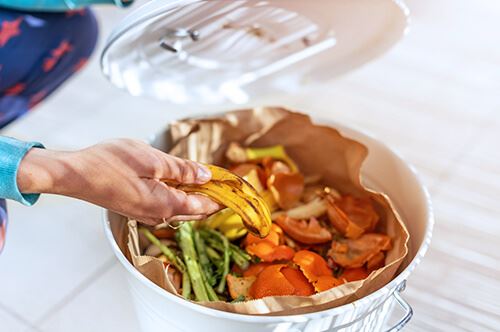 Green matter includes fruit and veggie peels and ends, loose leaf tea (be careful with bagged tea, some of the bags contain plastic material), coffee grounds, freshly mown grass, weeds, and garden clippings (don't put seed heads in).
Green matter includes fruit and veggie peels and ends, loose leaf tea (be careful with bagged tea, some of the bags contain plastic material), coffee grounds, freshly mown grass, weeds, and garden clippings (don't put seed heads in).
Dead leaves in the fall are one of the best and easiest ways to add brown matter to your compost bin. Going over them with the lawnmower to chop them into smaller bits will help them break down faster.
Keeping Your Compost Moist
The last ingredient your compost needs to work properly is water. If it's bone dry, nothing will happen, and if it's too wet, it will start to stink. It should have about the same moisture level as a wrung-out kitchen sponge.
Turning Your Compost
Turning and aerating your compost is critical if you want your compost to break down into beautiful soil fast. If you just put all the things in your bin and leave it to sit, it will break down eventually, but it could take more than a year.
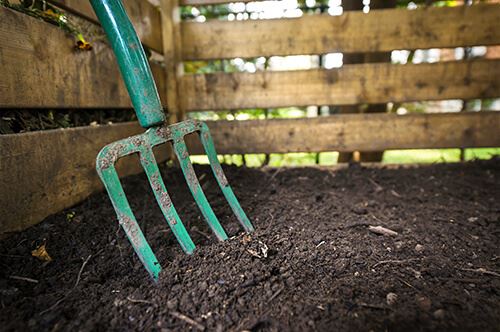 Turning or mixing your compost introduces air and moves larger pieces into the hotter interior to breakdown more quickly. An active compost pile can ideally get to 120-160 degrees, as materials are broken down it will cool and reduce in size. If you don't have a bin that rotates with a handle, there are a few different styles of compost turning tools available. A garden fork and a good shovel are the best tools to chop through any heap. If the pile starts to smell it is a good time to turn it.
Turning or mixing your compost introduces air and moves larger pieces into the hotter interior to breakdown more quickly. An active compost pile can ideally get to 120-160 degrees, as materials are broken down it will cool and reduce in size. If you don't have a bin that rotates with a handle, there are a few different styles of compost turning tools available. A garden fork and a good shovel are the best tools to chop through any heap. If the pile starts to smell it is a good time to turn it.
Using Your Compost
You will know that your compost is ready to use when it is dark and crumbles and it will have a very rich, earthy smell. The time needed to use your compost varies depending on the conditions (temperature and moisture), type of composting bin and materials added. On average you can have finished compost after a few months. Finished compost can be used in the garden and in potting soil where it helps introduce nutrients that may be lacking, improve water holding, and introduce healthy soil organisms that aid in plant growth.
Don't be intimidated by composting; it's actually pretty simple once you get a system set up, and your garden will absolutely love you for it.

